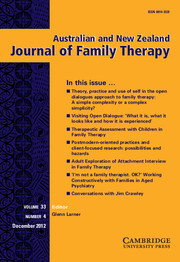Article contents
The Neurosequential Model of Therapeutics: An Interview with Bruce Perry
Published online by Cambridge University Press: 06 November 2012
Abstract
In this interview with Bruce Perry, MD, PhD, Senior Fellow of The Child Trauma Academy, Laurie MacKinnon discusses with Dr Perry developmental trauma and the Neurosequential Model of Therapeutics, an approach to clinical problem solving that utilises a developmental lens and incorporates advances in neurobiological development. Dr Perry gives his perspective on the causal connection between childhood abuse and later psychiatric diagnosis, the child's contact with a violent parent post-separation, the importance of interventions that address the organisation and functioning of lower parts of the brain and his perspective on the use and limitations of psychotropic medications, cognitive behaviour therapy and family therapy.
- Type
- Articles
- Information
- Australian and New Zealand Journal of Family Therapy , Volume 33 , Issue 3: Trauma and Systemic Therapy , September 2012 , pp. 210 - 218
- Copyright
- Copyright © The Authors 2012
References
- 6
- Cited by




